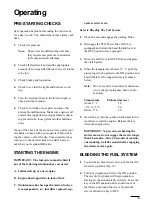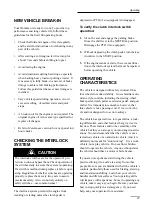
21
Operating
NEW VEHICLE BREAK-IN
Your Workman is ready for work. To provide top
performance and long vehicle life, follow these
guidelines for the first 100 operating hours.
•
Check the fluid and engine oil levels regularly
and be alert for indications of overheating in any
part of the vehicle.
•
After starting a cold engine, let it warm up for
about 15 seconds before shifting into gear.
•
Avoid racing the engine.
•
Avoid situations requiring hard stops, especially
when hauling heavy loads or pulling a trailer. It
is necessary to fully break-in a new set of brake
linings to achieve full braking performance.
Follow this guideline whenever new linings are
installed.
•
Vary vehicle speeds during operation. Avoid
excessive idling. Avoid fast starts and quick
stops.
•
A break-in oil for the engine is not required. The
original engine oil is the same type specified for
regular oil changes.
•
Refer to Maintenance section for any special low
hour checks.
CHECKING THE INTERLOCK
SYSTEM
The interlock system prevents the engine from
cranking or starting unless the clutch pedal is
depressed or PTO (if so equipped) is disengaged.
To verify the clutch interlock switch
operation:
1. Sit on the seat and engage the parking brake.
Move the shift lever to the NEUTRAL position.
Disengage the PTO (if so equipped).
2. Without depressing the clutch pedal, turn the key
clockwise to the START position.
3. If the engine cranks or starts, there is a malfunc-
tion in the interlock system that must be repaired
before operating the vehicle.
OPERATING
CHARACTERISTICS
The vehicle is designed with safety in mind. It has
four wheels for added stability. It uses familiar auto-
motive style controls, including the steering wheel,
brake pedal, clutch pedal, accelerator pedal, and gear
shifter. It is important to remember, however, that
this vehicle is not a passenger car. It is a work vehi-
cle and not designed for use on roadways.
The vehicle has special tires, low-gear ratios, a lock-
ing differential, and other features that give it extra
traction. These features add to the versatility of the
vehicle but they can also get you into dangerous situ-
ations. You must remember that the vehicle is not a
recreation vehicle or an all-terrain vehicle. And it is
definitely not meant for “stunt driving”. It is a work
vehicle, not a play vehicle. Do not allow children
should to operate the vehicle. Anyone who operates
the vehicle should have a motor vehicle license.
If you are not experienced at driving the vehicle,
practice driving it in a safe area away from other
people. Be sure you are familiar with all the vehicle’s
controls, particularly those used for braking, steering
and transmission shifting. Learn how your vehicle
handles on different surfaces. Your operating skills
will improve with experience, but as in operating any
vehicle, take it easy as you begin. Be sure you know
how to stop quickly in an emergency. If you need
help, ask your supervisor for assistance.
The interlock switches are for the operator’s pro-
tection, so do not bypass them. Check operation of
the switches daily to assure the system is operating.
If a switch is malfunctioning replace it before oper-
ating. Regardless of whether switches are operating
properly, replace them every two years to assure
maximum safety. Also, do not rely entirely on
safety switches—use common sense!
CAUTION
















































